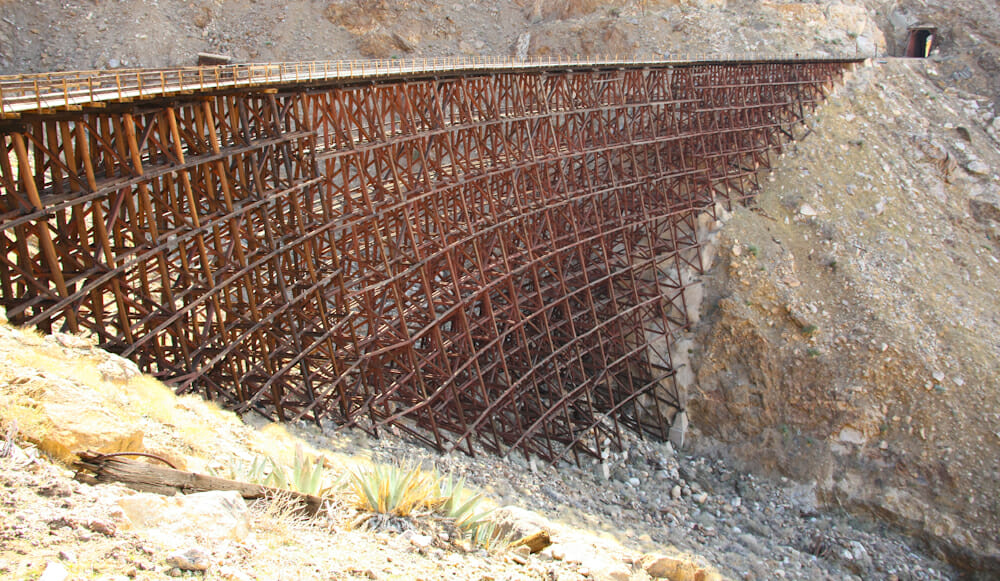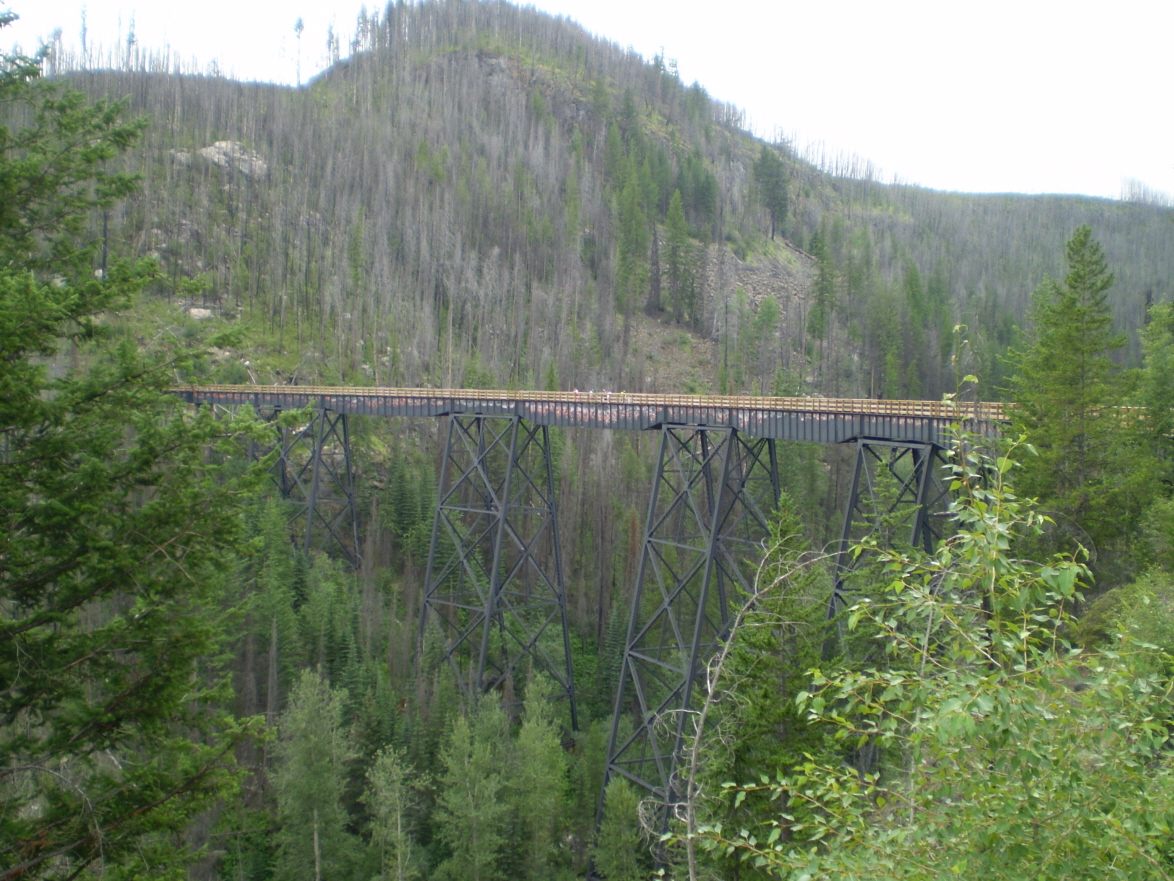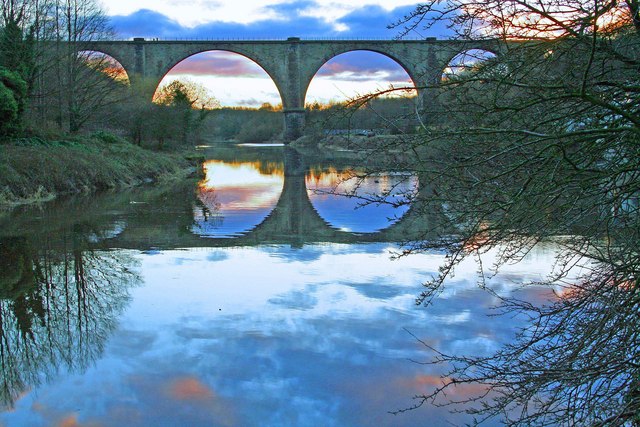11 Of The Most Amazing Abandoned Railroad Bridges Still Standing Today - Updated February 2023
With the hundreds of thousands of miles of abandoned railroad corridors in the world, it's no surprise that some of the most amazing infrastructure humanity has ever built was eventually abandoned, or re-purposed.
And indeed, many bridges, trestles and viaducts have been lost to history, such as the Brushy Creek Viaduct in Alabama. But there are also many which still stand today which serve as reminders of bygone days, the folly of man, or the power of Mother Nature, or some combination thereof. Here are 11 such bridges.
11) Goat Canyon Trestle, Jacumba Hot Springs, CA (32.729167, -116.183333)
Goat Canyon Trestle is the largest standing (for now) wooden trestle in the United States, and in spots is 200 feet off the ground, and 750 feet long. Built in the 1930's, it's actually a lot younger than it looks, since by the 1930's, steel had all but replaced wood as the preferred construction material for bridges. It was made out of wood due to the amazing temperature fluctuations that occur in its harsh desert environment, which would deteriorate a steel structure much quicker than wood. The prevailing winds are also why it was built at a slight 14 degree curve.
10) Myra Canyon Trestles, between Midway and Penticton, BC, Canada.
The Kettle Valley Railway was built in the early 20th century, in response to American mining activity in southern British Columbia, and miners using the Northern Pacific Railway south of the border, to transport materials. Thus, like the Transcontinental Canadian Pacific, the Kettle Valley Railway (itself a CP subsidiary) was built to reassert Canadian fiscal control over the region. This was no easy task, going over two mountain ranges, and required some of the most expensive engineering projects in North America to complete.
The most amazing of which was the stretch through Myra Canyon, which required 2 tunnels and 18 trestles to navigate a roughly 6 mile stretch. All of the Kettle Valley Railway was abandoned by 1989, but thankfully, many of these trestles still survive along the route today as the Kettle Valley Trail.
9) Victoria Viaduct over the River Wear, North East England (54.8847, -1.5028)
The Victoria Viaduct was built for the Durham Junction Railway, beginning construction in 1836 and completing two years later. It was last used in for rail traffic in 1991. Its design was based on the (much) older, and still standing, Alcántara Bridge in Spain, built early in the 2nd century by the Roman Empire.
The viaduct is 120' feet high and over 800 feet long, and at the time of its construction, was one of the largest bridges in Europe, of any variety.
8) Michigan Central Bridge - Niagara Falls, ON to Niagara Falls, NY (43.108546, -79.058368)
7) Leaderfoot Viaduct over the River Tweed - Melrose, Scotland (55.60443, -2.677939)
And indeed, many bridges, trestles and viaducts have been lost to history, such as the Brushy Creek Viaduct in Alabama. But there are also many which still stand today which serve as reminders of bygone days, the folly of man, or the power of Mother Nature, or some combination thereof. Here are 11 such bridges.
11) Goat Canyon Trestle, Jacumba Hot Springs, CA (32.729167, -116.183333)
 |
| Image: CoachellaValley.com |
Built for what was nicknamed the Impossible Railroad (the San Diego & Arizona Eastern), it was last used in 2008, although has had long periods of dormancy throughout its life. In fact, the Baja California Railroad is currently studying the feasibility of returning service to this bridge, meaning it may soon become an instance of a reactivated railroad corridor.
Sadly, as of 2022, it appears as though reactivation efforts have been abandoned by the Baja California Railroad, although there are still efforts to try and reactivate the line, though no work appears imminent.
For now though, it remains an amazing throwback to the past, and a popular destination for hikers, cyclists, and hang gliders:
10) Myra Canyon Trestles, between Midway and Penticton, BC, Canada.
The Kettle Valley Railway was built in the early 20th century, in response to American mining activity in southern British Columbia, and miners using the Northern Pacific Railway south of the border, to transport materials. Thus, like the Transcontinental Canadian Pacific, the Kettle Valley Railway (itself a CP subsidiary) was built to reassert Canadian fiscal control over the region. This was no easy task, going over two mountain ranges, and required some of the most expensive engineering projects in North America to complete.
The most amazing of which was the stretch through Myra Canyon, which required 2 tunnels and 18 trestles to navigate a roughly 6 mile stretch. All of the Kettle Valley Railway was abandoned by 1989, but thankfully, many of these trestles still survive along the route today as the Kettle Valley Trail.
 |
| Trestle Number 6 as part of the Kettle Valley Trail. Image: https://www.hikingswbc.com/page2-4/page2-4-10/page2-4-10.htmlhttps://www.hikingswbc.com/page2-4/page2-4-10/page2-4-10.html, 2010 |
 |
| Image: Andy Brass, 2007, geograph.org.uk |
8) Michigan Central Bridge - Niagara Falls, ON to Niagara Falls, NY (43.108546, -79.058368)
The Michigan Central Bridge often gets confused with the nearly adjacent Whirlpool Rapids Bridge, however it no longer carries railroad traffic from Canada into the United States, or vice versa. It was built to replace the Niagara Cantilever Bridge in 1925 for the Michigan Central Railroad, which later became part of the Penn Central Railroad. The Bridge was purchased by Canadian Pacific in 1990, and has been considered for demolition since 2001, although it still stands as of the time of this writing. A large concrete barrier on either side of the bridge prevents people from walking on it, as it does straddle an international border.
7) Leaderfoot Viaduct over the River Tweed - Melrose, Scotland (55.60443, -2.677939)
| Image: TransportTrust.com |
Back across the pond we go to the United Kingdom, and another arch bridge, the Leaderfoot Viaduct was built in 1863 for the Berwickshire Railway, and remained in revenue service until 1965. It was originally scheduled to be demolished in the late 1980's due to its deteriorated condition, but was saved by Historic Scotland in the early 1990's who would renovate the structure for preservation.
6) Seven Mile Bridge - Marathon, FL (24.6982, -81.1767)
 |
| The original bridge in the foreground, closed to traffic today. Image: Tinsley Advertising, 2008 |
The original Seven Mile Bridge (and indeed, the entire Overseas Railroad) was built by Henry Flagler in the early 20th century to connect Key West, FL to mainland Florida. I've talked before about how that worked out. Flagler, the Patriarch of the Florida East Coast Railway, envisioned a line to connect mainland Florida with the Florida Keys, ending at Key West. It wound up costing over $50 Million, as 4,000 men battled three hurricanes in the seven years it took to complete the line.
The route was destroyed by the Labor Day Hurricane in 1935. The route would be sold to the US Government to extend US-1 along and near the former right-of-way. Today, the original bridge still stands, but merely as a fishing bridge, and no thru traffic is possible.
5) Putrajaya Monorail Bridge - Putrajaya, Malaysia (2.943095, 101.699373)
 |
| Monorail Bridge photo by GuillaumeG, Wikipedia Commons. |
A common complaint I hear whenever a new construction project is proposed is why the Phase I planning process is so expensive and takes so long when "nothing is getting done". And the answer to that is because it is in this process that proposals for other alternatives are considered, environmental issues are realized, and so are funding and costs for the entire project. A few million dollars in planning money can save a government hundreds of millions down the road if the project runs out of money or is no longer viable for any number of reasons.
This is all very important to know beforehand, so you don't spend millions on the frame for a new bridge without the rest of the route being built. This bridge was built in 2004, but budget constraints forced the cancellation of construction for over a decade, and while construction is still technically being considered (with a completion date of 2021), it is at best 17 years behind schedule, and at worst will be an example of a bridge to nowhere.
NOTE: As of 2021, construction has resumed on the monorail and is projected to open in 2025!
4) Viaduc du Caramel - between Menton and Sospel, France
 |
| Image: Wikipedia Commons |
The Viaduc du Caramel is a French example of an arched viaduct, built in 1910 for the Nice and Littoral Tramway company, and open for service two years later. By 1931, the line was closed.
_Est.jpg) |
| Old Postcard showing the Viaduct in 1912. |
Sadly, not being able to read French, I do not have a ton more information on this viaduct, however if you can, this site does.
3) Million Dollar Bridge - Cordova, AK (60.6731, -144.74583)
The Miles Glacier Bridge, better known as the Million Dollar Bridge, was built in 1909 for the Copper River & Northwestern Railway, one of the most financially successful railroad projects in Alaska, and indeed the United States.
.jpg) |
Miles Glacier Bridge in 2008. The far left span as seen in this photo shows the repairs performed in 2004. (Wikipedia Commons) |
Built to connect the Kennecot copper mine near McCarthy, AK with the coast at Cordova, the CR&NW railway was 192 miles long and cost over $25 million in total. In spite of the cost, the railroad would move over $200 million in copper at a 50 percent profit.
The railroad ended service in 1941 when the mine was depleted and no longer profitable. The right-of-way and bridge were donated to the United States to become the McCarthy Hwy. The Good Friday Earthquake of 1964 would partially collapse one span of the bridge, and from there, its fate was in jeopardy. The McCarthy Hwy was rerouted and the bridge was dormant. Nonetheless, it was eventually decided it would be cheaper to repair the bridge than demolish it, or let it deteriorate further, as a collapse would have a significant impact on the migration of salmon in and out of Miles Lake. Repairs were completed in 2005.
2) Kinzua Bridge - Mt. Jewett, PA (41.75753, -78.5876)
I've already talked twice about the Kinzua Bridge, having visited it last July, so I'll keep this relatively short. The Kinzua Bridge was the 4th tallest railroad bridge in the United States, and considered the 8th wonder of the world. While abandoned for freight traffic relatively early in its life due to its height, which required trains to go no more than 5 mph, it remained in service as a tourist railroad, the Knox & Kane Railroad, until 2002. One year later, before needed repairs could be made on the bridge, half of its structure was destroyed in a tornado. Rather than rebuild it, the State of Pennsylvania decided to leave the bridge in its state, and show the absolute brute force of nature, rebuilding the remaining half as a walkway, not for the faint of heart.
1) Vance Creek Bridge - Mason County, WA (47.334639, -123.321722)
The railroad ended service in 1941 when the mine was depleted and no longer profitable. The right-of-way and bridge were donated to the United States to become the McCarthy Hwy. The Good Friday Earthquake of 1964 would partially collapse one span of the bridge, and from there, its fate was in jeopardy. The McCarthy Hwy was rerouted and the bridge was dormant. Nonetheless, it was eventually decided it would be cheaper to repair the bridge than demolish it, or let it deteriorate further, as a collapse would have a significant impact on the migration of salmon in and out of Miles Lake. Repairs were completed in 2005.
2) Kinzua Bridge - Mt. Jewett, PA (41.75753, -78.5876)
 |
| My 2018 photo of the bridge's underbelly. |
 |
| Destroyed ruins of the Kinzua from the end of the remaining section. (Andrew Grigg, 2018). |
| Image: Vance Creek Bridge at HighestBridges.com |
Vance Creek Bridge has appeared in numerous abandoned bridge lists and many urbex sites all over the web for one simple reason, it looks terrifying, even from a computer monitor! Built in 1929 for the Simpson Logging Company, it is 347 feet tall and over 400 feet long.
 |
| Vance Creek Bridge with a locomotive crossing it - Wikipedia Commons. |
Once Simpson logging stopped using the bridge in the 1970's, it became a favorite for trespassers. Proposals have been made to convert the bridge into a trail, however a lack of funding and prohibitively high insurance costs made the project fall through. The structure is still standing, but the railroad ties and approach structure were removed in 2017 in an attempt to stop trespassers from making their way onto the bridge.
Nonetheless, that hasn't stopped people from shooting photos and videos.
With the huge amount of railroad infrastructure across the world, there are no doubt examples of bridges which are interesting, but didn't make this list for any number of reasons, mainly that I didn't know they exist or didn't come to my mind when making this list. I hope you enjoyed today's blog, and let me know if there's any other bridges you believe should be here in the comments, thanks for reading!
Nonetheless, that hasn't stopped people from shooting photos and videos.
With the huge amount of railroad infrastructure across the world, there are no doubt examples of bridges which are interesting, but didn't make this list for any number of reasons, mainly that I didn't know they exist or didn't come to my mind when making this list. I hope you enjoyed today's blog, and let me know if there's any other bridges you believe should be here in the comments, thanks for reading!




Nice to see Leaderfoot Viaduct there. I know it very well.
ReplyDelete#8 Michigan Central Bridge
ReplyDeleteI don't want to scare anybody, but the Bridge next to it was built in 1897 and it still is in use today. See Whirlpool Bridge, Niagara Falls, NY
wonder what would become of all the scrap metal if the michigan central bridge is demolished.
ReplyDeleteCheck out the Poughkeepsie RR bridge, and the nearby Rosendale trestle.
ReplyDeleteMany thanks for remembering the Nice (France) streetcar which leaving the tracks in the avenues climbed high into the Maritime Alps.
ReplyDeleteRan many trains over the Goat Canyon Trestle for Carrizo Gorge Railway! Trestle is 633 feet long, 185 feet tall with a 15 degree curve on the east end! Built in 1932!
ReplyDeleteViaduc du Caramel is also covered on my English speaking site:
ReplyDeleteIn many trips to Nice and Les Alpes-Maritimes, my wife and I have seen a significant amount of engineering works, bridges, viaducts and tunnels all on lines which were neither part of the PLM network of standard gauge railways, nor part of the general metre-gauge network. It turns out that there were a significant number of lines operated by two main tramway companies in Provence, Tramways de les Alpes Maritime (TAM) and tramways de Nice et du Littoral (TNL).
These tramways ran on metre-gauge tracks but had a loading gauge not much wider than the track-gauge. In many places they ran alongside roads or withing the highway itself, but often they deviated away from the highway or their own formation.
The one which first drew our attention was the Sospel to Menton Tramway which included the Viaduc du Caramel and which was operated by the TNL. This is the story:
https://rogerfarnworth.wordpress.com/2018/02/23/the-sospel-to-menton-tramway-revisited-chemins-de-fer-de-provence-51